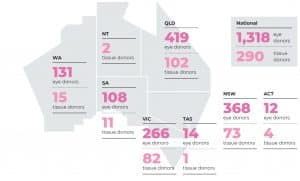The Australian Government’s latest report on organ and tissue donation shows 2,277 Australians received corneal transplants in 2020 from 1,318 donors, figures a leading eye bank director says are remarkable considering donations dropped by 50% at the peak of COVID-19 lockdowns.
Lions Eye Donation Service (LEDS) director Dr Graeme Pollock, who founded the Melbourne-based organisation in 1991, was commenting on the release of the 2020 Australian Donation and Transplantation Activity Report that found eye donations and corneal transplants were only slightly down on the year before.
The figures show in 2020 there were 190 fewer eye donations (a 13% drop) than in 2019, and 137 fewer corneal transplants (a 6% decrease).
Pollock said the figures were strong considering corneal donations dropped by half across Australia during the initial lockdown from March through April. But that coincided with a shutdown on elective surgery, which meant only 30-50% of usual corneal surgeries were being performed.
“So, we were still able to meet demand over that period, mainly for Category 1 patients,” he said. “And in May when a lot of the lockdowns were eased, some states experienced a rebound effect in terms of the number of transplants needed, and indeed we were lucky enough to see a rapid recovery in donations to cope with that.”

However, from July to October, Pollock said lockdowns – particularly in Victoria – put pressure on donor referral systems out of hospitals, which rely on staff having donation front-of-mind.
Organ donor consent rates also dropped. With bereavement being challenging at the best of times, this was amplified during COVID-19 with restrictions on travel and funeral numbers.
“Making a decision on donating organs and tissues was another complication to think about for families at what is already a very difficult time,” he said.
COVID policies
In recent months, there have been several studies investigating the presence of COVID-19 in the eye and whether it can be transmitted via donated corneas.
With a known incubation period of 14 days, Pollock said eye banks have been taking an “ultra conservative approach” and will only accept a cornea from a previously infected COVID patient if it is donated 28 days or more after their initial diagnosis.
He said most donations came from the hospital environment, meaning they would have already been tested.
“We also know that the preparations we use, which are similar to the preparations someone would undergo pre-operatively for eye surgery, are very effective at eliminating the virus,” he said.

“Even though there have been some virus particles detected in the cornea itself in two donors in the US – and remember in the US we are talking about tens of thousands of donors – it wasn’t very clear if that virus was living or viable.
“The bottom line is there has never been a substantiated report of coronavirus being transmitted by transplantation of a cornea, tissue, organ and even blood, including SARS or MERS, so the precautions that we take are ultra conservative. There is an extraordinarily low risk of COVID transmission in this way, in fact no one in the world has experienced it.”
A world leading system
The 2020 report also had a state-by-state breakdown of eye donations. Queensland had the highest rate with 419, followed by New South Wales (368), Victoria (266), Western Australia (131), South Australia (108) and Tasmania (14).
Pollock said donations have continued to climb since mid-October, returning to 2019 levels. He said Australia’s donation figures were “remarkably good” when compared to other developed countries.
“Whilst we went down about 50% at one point, in the US, for example, activity in April through to June was about 6% of pre-COVID activity, so eye banking almost shut, in fact many eye banks did, and the US has slowly recovered,” he said.
“Domestically, the US are still probably about 75% of what they were doing beforehand and, of course, they supply many international transplants as well which are down to about 15-20% of what they used to be.”
Pollock said while Australia’s eye banks (located in Brisbane, Perth, Sydney, Adelaide and Melbourne) worked independently, they had an informal network of sharing tissue on an as-needed basis. They also worked with the Auckland eye bank, with some tissue also sent to New Zealand.
“We are very fortunate in Australia that our system means we are very well-serviced for the provision of corneas and we are probably only one of a handful of nations in the world that’s self-sufficient and sustainable,” he said.
More than 23,500 Australians have received a corneal donation since the national program began in 2009. The report can be found here.
More reading
Screening vital to eliminating COVID transmission risk through donor cornea
Advances in treating corneal disease – feature
Man regains sight after world-first artificial cornea implantation




